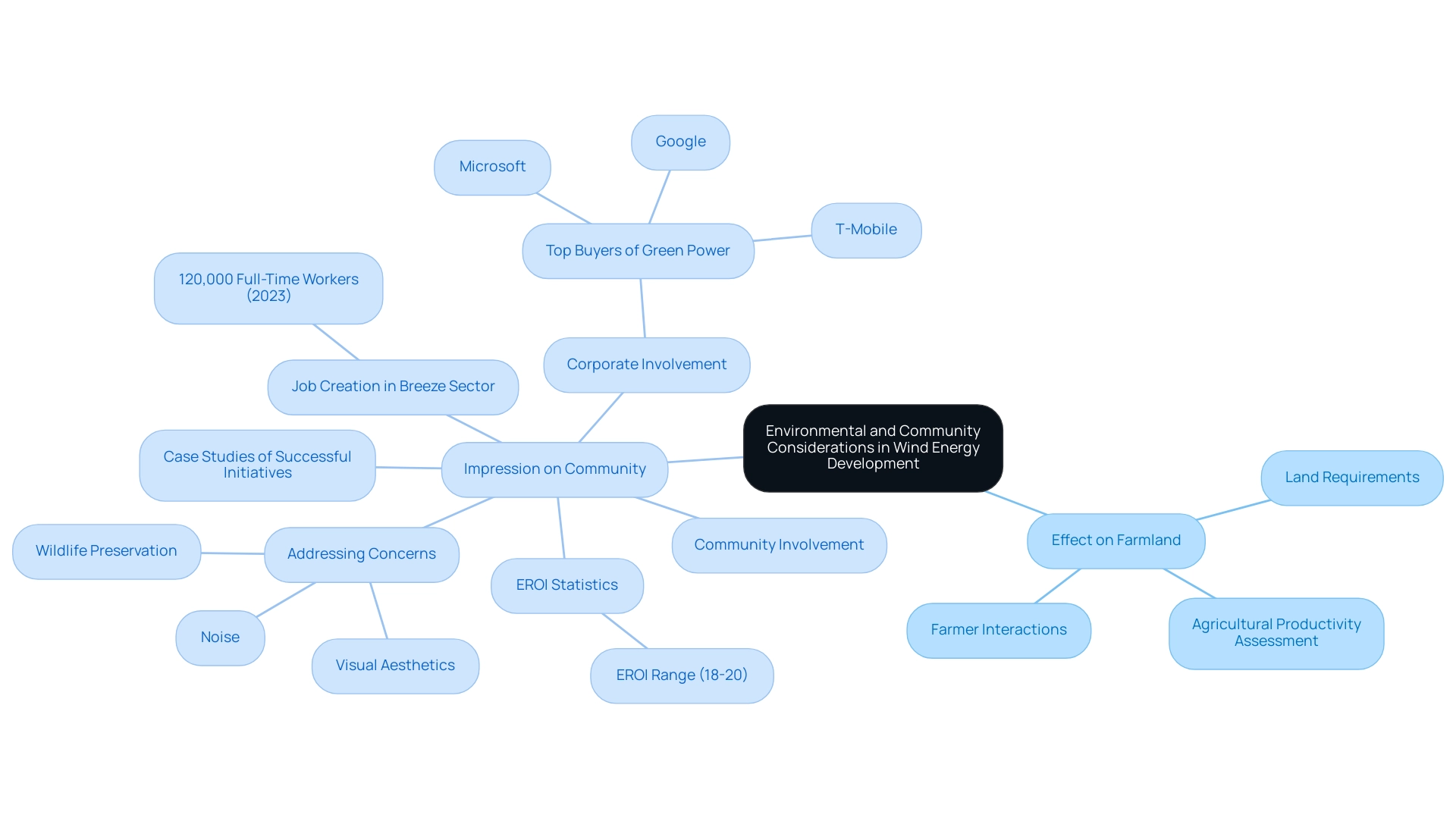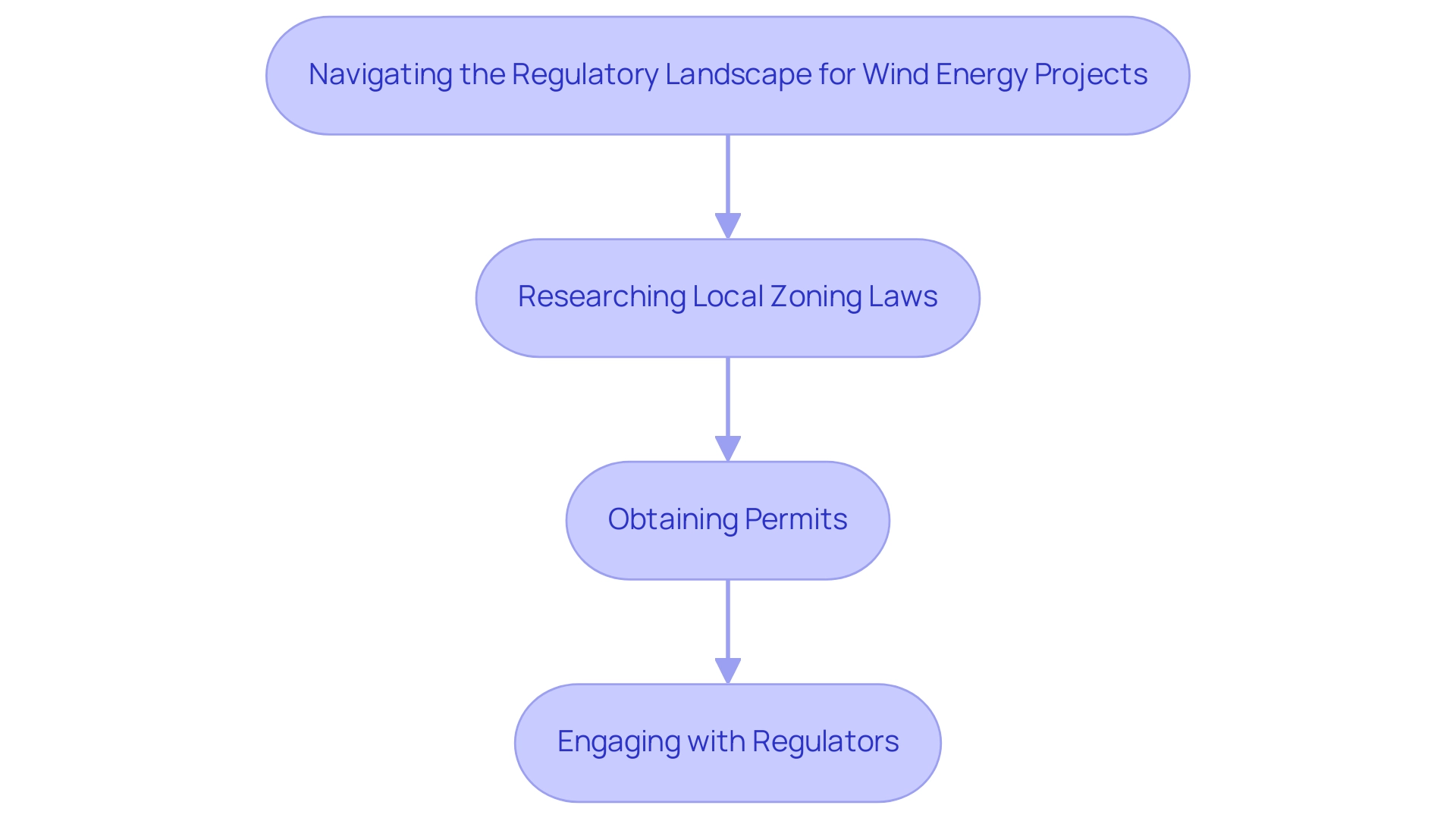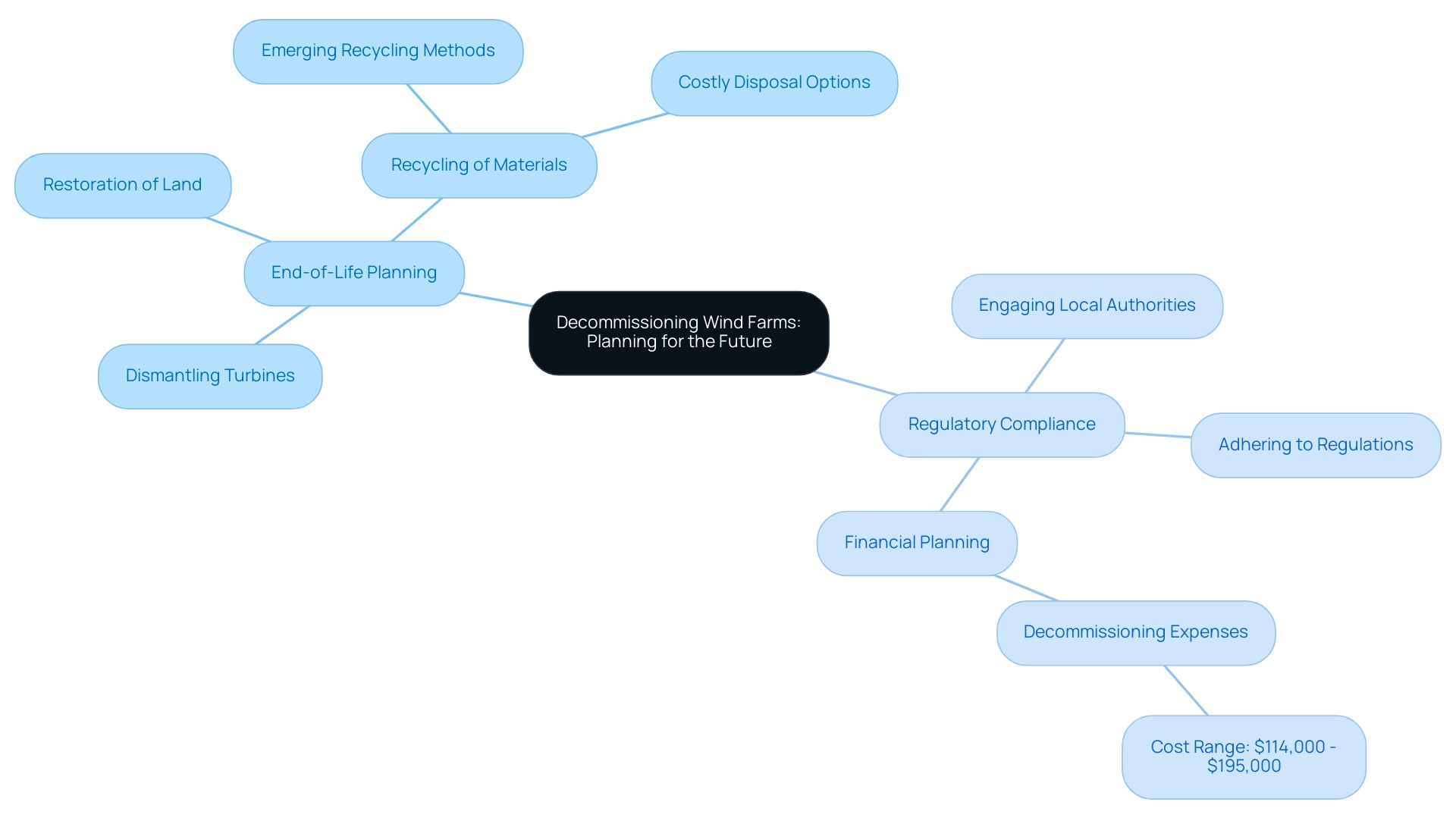Introduction
The evolution of wind energy as a cornerstone of renewable resources necessitates a comprehensive understanding of the regulatory frameworks and community dynamics that govern its development. As wind energy projects proliferate, the significance of land regulation becomes increasingly apparent, influencing site selection, permitting processes, and community engagement.
This article delves into the critical components of wind energy land regulation, examines the environmental and community considerations essential for successful project implementation, and navigates the intricate regulatory landscape that developers must traverse. Furthermore, it explores the economic implications and financial structures that underpin these projects, alongside the vital aspects of decommissioning wind farms responsibly.
By addressing these multifaceted elements, stakeholders can better position themselves to harness the full potential of wind energy in a sustainable and community-oriented manner.
Fundamentals of Wind Energy Land Regulation
[[[Wind energy land regulatory services is a multifaceted area that plays a critical role in the successful development of renewable energy initiatives. It encompasses essential components such as site selection, right-of-way acquisition, and adherence to a variety of legal frameworks at local, state, and federal levels. Grasping these fundamentals is essential for adherence and the efficient execution of tasks.
Key terms include:
- Wind Farm: A designated area featuring multiple turbines designed specifically for electricity generation.
- Right-of-Way: The legal entitlement permitting passage through property owned by another entity, essential for the placement of infrastructure associated with renewable projects.
- Permitting Process: A structured sequence of approvals required from regulatory agencies prior to the commencement of construction activities.
The importance of these elements is highlighted by results indicating that, as of 2024, adherence to wind energy land regulatory services remains a crucial factor in success. The Hamilton Project and Energy Policy Institute at the University of Chicago emphasize that while progress has been made in addressing climate change, significant challenges remain, highlighting the need for [efficient wind energy land regulatory services in renewable initiatives. Notably, Rand et al. (2024) document that batteries constitute approximately 99 percent of the storage capacity in the planning queues, illustrating the increasing integration of hybrid configurations with generation and the importance of storage solutions in optimizing wind projects.
Additionally, public sentiment towards wind power is generally favorable, with 92% of individuals living within five miles of a wind turbine reporting positive or neutral experiences. This highlights the significance of interacting with community groups to reduce opposition. Case studies show that 73% of disputed initiatives encounter difficulties mainly at state or regional levels, highlighting that tackling these community issues can greatly simplify the permitting process and improve the overall success of clean power efforts.
Environmental and Community Considerations in Wind Energy Development
The advancement of airborne power offers a variety of important ecological and societal effects that need to be meticulously handled. Key considerations include:
-
Effect on Farmland: Wind energy land regulatory services indicate that wind turbines require substantial land, which can disrupt existing agricultural practices. It is crucial to evaluate the agricultural productivity of the area before proceeding with development.
Interacting with nearby farmers to comprehend their needs and concerns can aid in reducing disruption and promoting a collaborative relationship.
-
Impression on Community: Effective community involvement is crucial for the success of wind energy initiatives. Comprehending regional sentiments and addressing concerns related to noise, visual aesthetics, and wildlife preservation can significantly enhance community support. Successful initiatives have demonstrated that when stakeholders feel their voices are acknowledged, the likelihood of opposition decreases. For instance, in recent case studies, projects that prioritized transparency and active communication with local residents achieved higher success rates in garnering community backing. Furthermore, as emphasized by a 2013 study, the power return on investment (EROI) for aerogeneration ranges between 18 and 20, illustrating its effectiveness and feasibility as a renewable power source. Additionally, as of April 2024, prominent firms such as Microsoft, Google, and T-Mobile have risen as top corporate purchasers of green power, highlighting an increasing trend in corporate responsibility and investment in renewable resources. This trend not only aids the shift to renewable resources but also highlights the potential for job creation, with over 120,000 full-time workers in the U.S. breeze sector as of 2023. A cooperative strategy for wind energy land regulatory services not only aids in execution but also enhances local economies and community relationships.

Navigating the Regulatory Landscape for Wind Energy Projects
Successful renewable power initiatives require compliance with numerous regulations, highlighting the importance of wind energy land regulatory services for a comprehensive understanding of the regulatory environment. Key steps include:
- Researching Local Zoning Laws: Each jurisdiction imposes its own set of regulations regarding energy installations, which can significantly influence site selection. For example, recent legislative alterations in Ohio under SB 52 have provided regional authorities greater control over the placement of wind installations, which enhances wind energy land regulatory services by enabling counties to limit zones for new facilities. Such local ordinances may also address concerns related to visual impact and airspace usage, emphasizing the need for developers to stay informed about specific local regulations concerning wind energy land regulatory services. Additionally, communities may implement ordinances related to wind energy land regulatory services to limit turbine height, which can directly influence planning and compliance strategies.
- Obtaining Permits: The permit acquisition process typically involves several critical components, including environmental assessments, building permits, and operational permits. Engaging with regulators early in the development process is vital to ensure that all requirements related to wind energy land regulatory services are met, thereby streamlining approval. In Wisconsin, for instance, the Public Service Commission manages siting authority for solar projects exceeding 100 MW, which emphasizes the significance of comprehending state-specific regulations. Furthermore, proposed legislation in Wisconsin would allow local governments to impose more restrictive regulations on turbine systems, emphasizing the need for wind energy land regulatory services and necessitating developers to be proactive in their compliance strategies. As pointed out by industry expert Lopez, we will continue to drill down our resolution and analyze different aspects of the interactions between land use and clean power deployment. This comprehension of land use dynamics is essential for the effective execution of renewable initiatives.

Economic Impacts and Financial Structures of Wind Energy Projects
The economic feasibility of wind initiatives is affected by several crucial elements. One primary consideration is the Payment Structure. Comprehending the compensation models for landowners is essential, as these can greatly influence feasibility.
Payments generally fluctuate between energy production-based royalties and fixed lease agreements, allowing for flexibility based on the landowner's preferences and specifics. A thorough analysis of the upfront investment compared to long-term returns is crucial for stakeholders seeking to evaluate the venture’s profitability. Financial tools such as cash flow analysis are invaluable for assessing expected returns over time.
Significantly, a standard turbine repays its carbon footprint in under six months and produces emission-free electricity for 20 to 30 years. This long-term perspective can greatly enhance investment attractiveness. Moreover, in the larger framework of renewable resources, utility-scale solar accounted for 19% (40,714 GWh) of electricity in California in 2023, highlighting the increasing importance of sustainable power sources.
Additionally, as observed by researchers at the University of Rhode Island, the development of turbine initiatives can result in unforeseen economic advantages, including a boost in tourism, illustrated by the surge in visitors near Rhode Island’s Block Island Wind Farm. Financial experts often emphasize that understanding these economic impacts is essential for landowners and stakeholders. These insights highlight the multifaceted economic impacts of energy projects, underscoring their viability not only as sustainable energy sources but also as valuable economic contributors in the regions they serve.
Decommissioning Wind Farms: Planning for the Future
Effective planning for the decommissioning of renewable energy farms encompasses several crucial considerations:
- End-of-Life Planning: It is essential to establish comprehensive guidelines that outline the dismantling of turbines, the restoration of land, and the recycling of materials. This approach not only supports sustainability initiatives but also significantly reduces the environmental footprint associated with decommissioning activities. Recent trends indicate that while new recycling methods for wind turbine components are emerging, they remain limited and costly, often leading to landfilling as the most economically viable disposal option. The case study on 'Current Trends in the Wind Turbine Decommissioning Market' highlights how technological innovations and strategic mergers are shaping the decommissioning landscape, offering insights into best practices that can be adopted.
- Regulatory Compliance: Adhering to regional regulations and environmental standards is paramount when developing decommissioning plans in accordance with wind energy land regulatory services. Engaging with local authorities early in the process can facilitate the development of a compliant strategy that mitigates the risk of penalties. As the turbine decommissioning market evolves, understanding the latest wind energy land regulatory services and compliance requirements is critical. Recent regulations highlight the necessity for sustainable methods in deconstructing renewable power initiatives. Decommissioning expenses per turbine can range from $114,000 to $195,000, underscoring the need for careful financial and regulatory planning. As noted in industry discussions, 'Clean energy finance increased until 2021,' reflecting varying regional priorities that influence funding distribution for decommissioning projects. By prioritizing these elements, stakeholders can navigate the complexities of wind farm decommissioning effectively.

Conclusion
The future of wind energy relies on a comprehensive understanding of:
- Land regulation
- Community dynamics
- Environmental considerations
Key factors such as:
- Site selection
- Right-of-way acquisition
- The permitting process
are essential for project success. Compliance with these regulations is crucial, especially given that many contested projects face challenges at local and state levels. Engaging communities to address concerns fosters support and streamlines the regulatory process, enhancing the viability of renewable energy initiatives.
Economic factors are equally significant in the development of wind energy. Financial structures, including payment models for landowners and long-term investment returns, illuminate the industry's economic potential. The benefits to local economies and job creation further emphasize the importance of embracing wind energy.
Additionally, responsible decommissioning practices are vital for minimizing the environmental impact of wind farms. Establishing clear guidelines for dismantling and land restoration ensures regulatory compliance and promotes sustainability. By focusing on regulatory adherence, community involvement, and economic viability, stakeholders can effectively maximize the potential of wind energy. This holistic approach is essential for advancing renewable resources and fostering a cleaner, more sustainable future.
Frequently Asked Questions
What is the role of wind energy land regulatory services?
Wind energy land regulatory services play a critical role in the development of renewable energy initiatives, encompassing site selection, right-of-way acquisition, and compliance with various legal frameworks at local, state, and federal levels.
What are some key terms associated with wind energy land regulatory services?
Key terms include: Wind Farm: An area with multiple turbines designed for electricity generation. Right-of-Way: Legal permission to pass through property owned by another entity for infrastructure placement. Permitting Process: A sequence of approvals required from regulatory agencies before construction begins.
Why is adherence to wind energy land regulatory services important?
Adherence to these services is crucial for the success of renewable initiatives, as highlighted by research indicating ongoing challenges in addressing climate change and the importance of efficient regulatory services.
How does public sentiment affect wind energy projects?
Public sentiment towards wind power is generally positive, with 92% of individuals living near wind turbines reporting positive or neutral experiences. Engaging with community groups can help reduce opposition to projects.
What challenges do wind energy initiatives face at the community level?
Case studies show that 73% of disputed initiatives encounter difficulties primarily at state or regional levels, emphasizing the importance of addressing community issues to simplify the permitting process and improve project success.
What ecological and societal effects must be considered in wind energy development?
Key considerations include the impact on farmland due to land requirements for wind turbines and the need for effective community involvement to address concerns related to noise, aesthetics, and wildlife preservation.
How can interaction with local farmers benefit wind energy projects?
Understanding farmers' needs and concerns can help reduce disruption to agricultural practices and promote a collaborative relationship during the development of wind energy projects.
What trends are emerging in corporate investment in renewable energy?
Prominent companies like Microsoft, Google, and T-Mobile are becoming top purchasers of green power, reflecting a growing trend in corporate responsibility and investment in renewable resources.
What is the potential for job creation in the wind energy sector?
As of 2023, there are over 120,000 full-time workers in the U.S. wind energy sector, indicating significant job creation potential associated with renewable energy initiatives.
List of Sources
- Fundamentals of Wind Energy Land Regulation
- Eight facts about permitting and the clean energy transition - The Hamilton Project (https://hamiltonproject.org/publication/economic-fact/eight-facts-permitting-clean-energy-transition)
- Wind Power Facts and Statistics | ACP (https://cleanpower.org/facts/wind-power)
- Environmental and Community Considerations in Wind Energy Development
- Wind Energy Factsheet (https://css.umich.edu/publications/factsheets/energy/wind-energy-factsheet)
- Navigating the Regulatory Landscape for Wind Energy Projects
- Wind, Solar and Siting: A Look at Recent Laws and Legislative Trends in the Midwest - CSG Midwest (https://csgmidwest.org/2024/02/29/wind-solar-and-siting)
- NREL Releases Comprehensive Databases of Local Ordinances for Siting Wind, Solar Energy Projects (https://nrel.gov/news/program/2022/nrel-releases-comprehensive-databases-of-local-ordinances-for-siting-wind-solar-energy-projects.html)
- WINDExchange: Wind Energy Ordinances (https://windexchange.energy.gov/projects/ordinances?per_page=100&page=5)
- Economic Impacts and Financial Structures of Wind Energy Projects
- Wind Power Facts and Statistics | ACP (https://cleanpower.org/facts/wind-power)
- A Decade of Growth in Solar and Wind Power: Trends Across the U.S. | Climate Central (https://climatecentral.org/report/solar-and-wind-power-2024)
- WINDExchange: Wind Energy's Economic Impacts to Communities (https://windexchange.energy.gov/projects/economic-impacts)
- Decommissioning Wind Farms: Planning for the Future
- forbes.com (https://forbes.com/sites/arielcohen/2024/12/23/hidden-costs-rusting-relics-decommissioning-wind-turbines-in-the-us)
- Global Wind Turbine Decommissioning Market Industry Best Practices 2024-2031 (https://statsndata.org/report/wind-turbine-decommissioning-market-307337)
- Wind Turbine Decommissioning Market Size, Growth, Trends, Report 2034 (https://marketresearchfuture.com/reports/wind-turbine-decommissioning-market-36937)
- visualizingenergy.org (https://visualizingenergy.org/the-decommissioning-of-wind-turbines-in-the-united-states)




